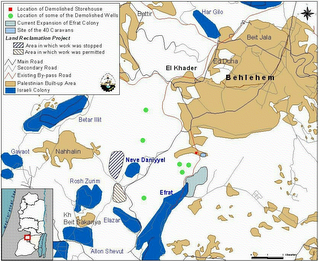It is worth mentioning that the government of Israel does not 'recognize Palestine', the government of Israel routinely uses violence against the Palestinian civilian population, and the government of Israel routinely breaks past peace agreements. The astounding hypocrisy of both the government of Israel and the International community in demanding that the Palestinian Unity government recognizes Israel, renounces violence and abides by past peace agreements is quite jaw dropping.
Settlement expansion, besides inflaming tensions and inciting violence also annexes Palestinian land in an ever expanding 'security zone' around the settlement; steals Palestinian resources such as water; causes environmental destruction as new roads and tunnels are built to connect the settlement to the Israeli road network thus also obstructing Palestinian movement as neighbourhoods become encircled by settlement bypass roads that are no-go zones to Palestinians; and pollute the Palestinian environment with untreated sewage and industrial pollutants through poor waste management practices.
Gov't promoting plan for new ultra-Orthodox East Jerusalem neighborhood
By Meron Rapoport, Haaretz Correspondent
Government bodies have been promoting a preliminary plan over the past few weeks to build a neighborhood of 11,000 units for the ultra-Orthodox near the East Jerusalem airport.The plan also calls for the construction of a tunnel under a Palestinian neighborhood to connect the new quarter to one of the settlements in the Beit El area east of Ramallah.MK Otniel Schneller (Kadima) said Tuesday that the Housing Ministry is the body that developed a plan to erect a massive new ultra-Orthodox neighborhood in East Jerusalem. The ministry denied any knowledge of the project.
Schneller also said Tuesday that the Jerusalem municipality was "happy with the idea." In response to Schneller's claims that the housing ministry hatched the plan, they said, "the ministry has no knowledge of this plan. At most, only the Jerusalem district of the ministry knew about it."The plan has not yet been submitted to the various planning committees since, according to Schneller, "it is only in the idea and feasibility stage."
The new neighborhood is to be built close to the separation fence near the Qalandiyah road block, which separates the Palestinian neighborhoods of north Jerusalem from Ramallah. If approved, it would be the largest building project over the Green Line in Jerusalem since the 1967 Six-Day War. The neighborhood, which will apparently be built on state or Jewish National Fund land would sit in the heart of one of the most crowded urban Palestinian areas in the West Bank. The architectural firm planning the project, Reches Eshkol, refused to divulge which government body had commissioned the plans. Despite the Housing Ministry's response, Haaretz has learned that the plan was presented a number of times to various official bodies, and that the director of the Housing Ministry's Jerusalem district, Moshe Merhavya, was present at least at one such instance.
Schneller said of the project: "I saw the plans in the programs division of the Housing Ministry and I very much enjoyed seeing them." Schneller explained that even though the Safdie Plan to construct housing in the western part of Jerusalem has been shelved, the need to build in Jerusalem still exists. "The ultra-Orthodox public needs its solutions," he said. "There is the possibility that it will conquer the inner city, and that this city will then become an ultra-Orthodox-Arab city, which I would not want to happen."
Schneller, who is the former head of the Yesha settlement council and now serves as Prime Minister Ehud Olmert's liaison to the settlers, said he has not yet spoken to the prime minister about the plan. "But from what I know of the government's position, there is an Israeli interest in establishing a neighborhood in Atarot. The plan proposes connecting the new neighborhood to the ultra-Orthodox settlement of Kokhav Yaakov east of Ramallah, which is at present outside the planned route of the separation fence. To this end, a tunnel a few hundred meters long would be dug beneath the Palestinian village of Aqab and under the separation fence. The idea to build an "eastern fence" to separate the settlements of the Jordan Valley and the mountains from large Palestinian communities like Ramallah had been raised in the past. The construction of the tunnel might be the first step in this direction.
"If it is someday decided that Kokhav Yaakov will be part of the 'Jerusalem envelope' it would be logical to create such a link, but it has not yet been decided," Schneller said. The municipality said that "when the plan is officially presented to the municipality, it will be discussed and a decision will be made about it." Some of the neighborhoods built around Jerusalem after the Six-Day War were planned by the Housing Ministry and were established over the objections of then-mayor Teddy Kollek. Meron Benvenisti, who served as deputy mayor at that time, said that the area has complex problems: prior to the Six-Day war some of its land belonged to municipalities like al-Bireh, which are today in the Palestinian territories.
"It is complete insanity to place tens of thousands of ultra-Orthodox Jews in the heart of a densely populated Arab area," he said. "No one thinks about how they will live there. It's like living in the middle of Ramallah." Attorney Danny Zindman of the Ir Amim association says such a plan will lead to the "balkanization" of Jerusalem.
